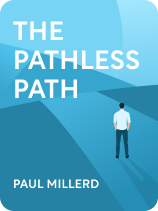

This article is an excerpt from the Shortform book guide to "The Pathless Path" by Paul Millerd. Shortform has the world's best summaries and analyses of books you should be reading.
Like this article? Sign up for a free trial here.
Have you experienced trauma? How might you turn it into something of value?
Paul Millerd embarked on a conventional career path by default. Two difficult events taught him one major lesson: stop prioritizing work, and start prioritizing life. He considers the shift he made to be an example of post-traumatic growth.
Continue reading to be inspired by Millerd’s story.
Millerd’s Change in Priorities
Post-traumatic growth happens when a crisis impels you to reconsider your values and make positive life changes. Millerd’s inspiring story is an example of post-traumatic growth.
Millerd explains that, because his parents followed traditional career paths, he assumed that he would, too. In college, he joined the honors program, and the friends he made in that program taught him to prioritize the appearance of success over meaningful college experiences. He wanted to become part of the elite (recall that succeeding at political games opens countless doors), so he avoided challenging classes and internships in favor of easy experiences, like classes he knew he’d ace, that he could use to pad his resume.
(Shortform note: The pressure to appear successful often begins with the college application process—many high school students believe they won’t get into top schools unless they meet unreasonable expectations regarding their academic success and extracurricular activities. Once they get into college, the pressure to perform continues, with many college students reporting that their desire to appear successful negatively affects their mental health. The pressure to become the best of the best may be linked to the pedigree effect (the fact that elite workplaces mainly hire graduates from the most elite colleges): Failing to excel at any point along the way may harm your ability to get a high-earning job.)
In the traditional workforce, Millerd vied for the top. He pursued a career in strategy consulting (advising businesses about their business strategies) because it was an elite profession: It paid six figures a year and earned respect. He landed jobs at prestigious businesses but left them quickly because they didn’t satisfy him. It was a normal part of the work culture at these businesses to dream about continuing to move up the ladder, which reinforced Millerd’s desire to accomplish better and better things—as a result, he decided to go to a top business school and keep climbing the corporate ladder.
(Shortform note: Millerd explains that despite his accomplishments during his traditional career, he was never satisfied and always felt driven to achieve more. Psychologists note that this kind of perfectionism can result from American culture’s emphasis on competitiveness, and it can have seriously negative consequences: For example, it can exacerbate self-esteem issues, result in exhaustion, and even lead to an early death. To tame your perfectionism, experts recommend taking stock of the ways it’s hurting you, setting more realistic goals, and creating healthy limits that help you know when enough’s enough.)
Why Millerd’s Priorities Changed
Millerd’s priorities changed because he had two painful experiences that caused him to question his values. The first was the death of his grandfather, whom he was close to, a month before Millerd started business school. While visiting his grandfather on his deathbed, Millerd realized his mind was still on his job—and it bothered him that work was taking precedence over one of the most important relationships of his life. This made him approach business school differently—he decided to prioritize his relationships over his classes, and his grades suffered for it.
As a result of this change in priorities, he didn’t get any of the elite job offers he’d hoped for—even his old job wouldn’t hire him back—and he ended up joining a more humble consulting business. Then, his second painful experience occurred: Immediately after he started there, he came down with a debilitating case of Lyme disease, and he had to take several months away from work. His identity was still fully wrapped up in his career, so he was desperate to return to work and keep achieving. However, that gradually began to change—he started blogging about his illness to cope and discovered that he enjoyed writing. A friend also helped him realize people would still love him even if he didn’t succeed in a traditional career.
Millerd says that, when he finally became healthy enough to return to work, he found it more disagreeable than he expected—he was more interested in personal fulfillment than in the work itself. Upon reflection, he realized that while work used to be the most important thing to him, he now valued spending time with loved ones, taking care of his health, and enjoying life over excelling in his career. He attributes this to a process called “post-traumatic growth,” where a crisis impels you to reconsider your values and make positive life changes.
| How an Existential Crisis Can Shift Your Priorities Experts explain that it’s common for painful events, like the loss of a loved one or ill health, to cause you to reevaluate your priorities. That’s because they can trigger an existential crisis—the sense that you no longer know who you are, why you’re living, or whether life can have any purpose or meaning, which is often accompanied by negative feelings like sadness, anxiety, and loneliness. Existential crises are especially likely to happen when your “false” and “true” selves are at war with each other, which occurs when you make life choices that make other people happy instead of pursuing what you authentically desire (for Millerd, this meant pursuing prestige over other meaningful parts of life). An existential crisis can lead to negative outcomes. First, you may spiral into a deep depression that some experts refer to as “the dark night of the soul,” a phrase inspired by the Christian mystic tradition. During this time, you might feel unable to cope with or change your circumstances or feelings; a sense of hopelessness can ensue as a result. Psychologists explain that this is an intensely difficult process—so difficult that some people choose to end their lives over it. However, there is hope: Experts say that the only way out of the dark night of the soul is to go through it. You must try your best to endure the discomfort, seeking help when necessary. On the other side of this depressive state, transformation awaits. Because the feelings that accompany an existential crisis are so uncomfortable, you’re prompted to reconsider your life choices, let go of your false self, and discover and pursue your true values. As Millerd explains, psychologists refer to this process as post-traumatic growth—and experts say there are five steps you can take to help this process along: First, learn more about the traumatic experience you’ve just had: What happened, why did it happen, and what are the consequences? Second, learn how to manage your negative emotions, for example via mindfulness techniques. Third, talk to someone (a professional or a friend) about your crisis—this will help you gain understanding and feel less alone. It can also help to hear from others about their crises. Fourth, decide on the story you’re telling yourself about what happened; consider both what you’ve lost and what you’ve gained (like a new perspective or clearer priorities). Finally, find a way to help others, as research suggests this can aid in healing and help you turn a negative into a positive. |
The Shift to Freelancing
When Millerd’s priorities changed, he knew that he needed to redesign his life around them—and the freelancers he encountered taught him that it was possible to design a life he’d truly enjoy.
As a freelancer, Millerd experienced total autonomy for the first time—he could work on his own terms, which energized him. However, he realized that he still defined his identity in terms of his career, which prompted him to think about his identity outside of work. He decided to prioritize recreation ahead of work and took a break from relentlessly pursuing freelance opportunities that forced him to work on projects he didn’t truly care about.
As a result of his choice to prioritize recreation, Millerd had a surge in creativity—he revamped his blog, started a podcast, and eventually started designing his own online consulting courses. This experience taught him that creative work was the only work he really found joy in.
Altogether, Millerd’s early freelancing experiences taught him that he wanted to work just enough to sustain himself and no more than that—he was now fully committed to living life to the fullest by prioritizing recreation, exploration, and joy. He got rid of most of his belongings, moved to Taipei, Taiwan, and embraced a minimalist lifestyle: few possessions and few responsibilities. This enabled him to lower his cost of living so that he could focus on his new priorities.
Millerd also decided that, instead of living for the weekend or waiting for retirement to do what he cared about, he’d incorporate exploration into his regular life by devoting intense energy to a new experience (like learning a new language or traveling) for a short period of time, then resting and moving on. He explains that this is a great way to experiment with what makes you happy—you’re not exhausting yourself by overcommitting, and you gradually figure out what really makes you happy and should be incorporated into your day-to-day life when you do eventually retire.

———End of Preview———
Like what you just read? Read the rest of the world's best book summary and analysis of Paul Millerd's "The Pathless Path" at Shortform.
Here's what you'll find in our full The Pathless Path summary:
- How to take a non-traditional approach to career success through freelancing
- Why Americans prioritize work and the disadvantages of this lifestyle
- One man's inspiring story of shifting from the workforce to freelancing






